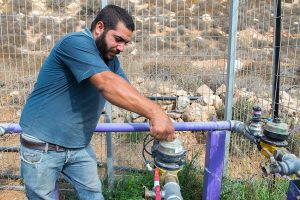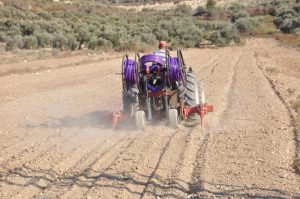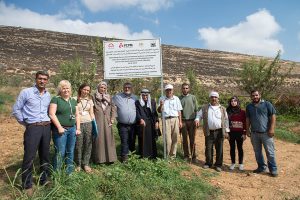Courtesy of ARIJ and PCPM
The world is becoming increasingly concerned about the negative impact of climate change, which includes heat waves, reduction of annual precipitation, shallow groundwater aquifers and increasing water salinization, land degradation, reduction of the biomass and vegetation cover, water scarcity, and reduced food production. In addition, the ongoing increase in world population is creating more pressure on our food supply and leaves poor people suffering from food insecurity and famine. Other parts of the world are suffering from increased flooding as polar and glacial ice is melting with unprecedented acceleration, whereas rising groundwater levels in low-lying areas prevent the cultivation of domesticated plants. These growing challenges are prompting scientists, researchers, planners, and decision makers to work intensively to help mitigate these challenges or reduce their fatal impact on the survival of the human race. Threats come in the form of natural crises and the unavailability of food and water, as well as the spread of diseases and epidemics associated with the rapid environmental changes. In Palestine, natural water scarcity is exacerbated by the occupation practices that limit the Palestinians’ access to water and land and pushes the population to leave their agricultural lands.
The solution is to look for other sources that can meet the growing demand on irrigation water, as the population increases and more food is needed. One alternative source is non-conventional water or treated wastewater. The Applied Research Institute – Jerusalem (ARIJ), with co-financing from the development cooperation program of the Ministry of Foreign Affairs of Poland and in partnership with the Polish Center for International Aid (PCPM), has been implementing agricultural demonstrations on farmland to serve as schools for farmers to learn how to use treated wastewater by establishing subsoil (subterranean) irrigation networks. This technology prevents direct contact between the produced fruit and the treated wastewater. The demonstrations started with a pilot program in the cultivation of fruit trees, such as pomegranate and seedless grapes, of industrial crops, such as safflower and luffa, and of alfalfa as green feed. The model is already in use in other countries, providing good produce and saving scarce freshwater by using treated wastewater for irrigation. This method also reduces the intensive usage of chemical fertilizers, as the treated wastewater already contains important nutrients such as nitrogen and phosphorus.*1
In an effort to utilize treated wastewater, the Applied Research Institute Jerusalem (ARIJ) in cooperation with the Polish Center for International Aid (PCPM) is introducing wastewater irrigation techniques for cultivating crops in the West Bank.
One demonstration of this method has been implemented in Wadi al-Arroub in Hebron Governorate, where ARIJ in the past had built a wastewater treatment unit with the capacity to treat 1,200 cubic meters of wastewater a day. The plan is to cultivate up to 500 dunums (one dunum equals 1,000 m2) with the treated wastewater over the coming years. It is hoped that through these demonstrations farmers will learn about the importance and benefit of using treated wastewater in agriculture, become convinced of the hygiene and safety of the system, and become familiar with this way of cultivating crops and the associated harvesting methods.
Project team in Wadi al-Arroub.
A similar demonstration is being implemented in Anza Village in Jenin Governorate and serves as a farmers’ school in the northern West Bank. Here, a wastewater treatment plant exists with a capacity of 132 cubic meters per day. The project works with the Anza village council and the farmers to improve the reuse of treated wastewater by introducing the subsoil drip irrigation technology to cultivate luffa, safflower, and alfalfa. The project aims to strengthen the farmers’ capacity to irrigate suitable crops with treated wastewater, teaching them how to harvest the products and how to handle them after harvesting, including processing and marketing.

irrigation system.
So far, the project has supported the cultivation of 17 dunums of irrigated lands with treated wastewater, and it will continue in the year 2019 by cultivating an additional 17 dunums, thus benefiting 40 farmers in Anza village and on the lands of Wadi al-Arroub. As part of the project, university students will conduct field visits to these farmers’ schools in order to learn the cultivation techniques and the procedures for reusing treated wastewater in ways that are consistent with Palestinian laws for reusing treated wastewater for irrigation.
This generated knowhow will also be transferred to other farmers in the West Bank, especially those having lands adjacent to the wastewater treatment units. To show the broader picture, there are 12 localities in total that run wastewater treatment plants, and 10.3 million cubic meters are collected annually and treated or partially treated in the West Bank.*2 Unfortunately, most of the treated wastewater is being released directly into the environment. Thus, there is a need to raise the awareness of farmers, organizations, and the general population concerning the proper use of treated wastewater in agriculture. In this way we hope to increase the area and prosperity of cultivated and irrigated lands through using environmentally sound practices, reducing pressure on the freshwater resources, and increasing individual farmers’ agricultural production.

The publication of this article is part of the project “Optimizing the use of conventional and non-conventional water for irrigation towards rural development and women and youth empowerment, Palestine,” co-financed within the framework of the Polish Development Cooperation of the Ministry of Foreign Affairs of the Republic of Poland and implemented by the Polish Center for International Aid (PCPM) in partnership with the Applied Research Institute – Jerusalem (ARIJ).
Article photos courtesy of ARIJ and PCPM.
*1 Timothy G. Ellis, Environmental and Ecological Chemistry, Vol II: Chemistry of Wastewater, available at http://www.eolss.net/ebooklib/ebookcontents/e6-13-themecontents.pdf.
*2 “Wastewater Management,” ARIJ, available at https://www.arij.org/files/arijadmin/weruinfographics.pdf.



